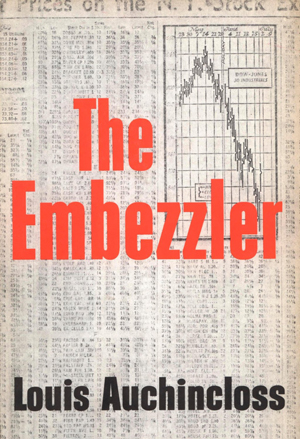Louis Auchincloss, who died in 2010, was one of America’s most prolific authors. Over his fifty-year career, he wrote 60 books, including 31 novels, several biographies, short story collections, works of literary criticism, and more. During most of his writing career he was employed full-time as an estate attorney.
The subject matter for his fiction oeuvre was derived from what he called “the comfortable world” — which when he was growing up in the 1920s and ‘30s meant an apartment or brownstone in town, a house in the country, a staff of five or six maids, two or three cars, several club memberships, a private school education for one’s children. His work was frequently compared with Edith Wharton’s, whose characters, settings, and plots originated in what was then called the world of “bluebloods,” or in today’s parlance, the “one-percenters.”
 It is therefore somewhat prescient that Auchincloss’s 1966 novel, The Embezzler, addressed an issue that would both dominate the headlines and affect a substantial portion of society 42 years later—namely flagrant malfeasance of highly placed and trusted members of the financial elite.
It is therefore somewhat prescient that Auchincloss’s 1966 novel, The Embezzler, addressed an issue that would both dominate the headlines and affect a substantial portion of society 42 years later—namely flagrant malfeasance of highly placed and trusted members of the financial elite.
Auchincloss was inspired by the documented facts of the 1938 Wall Street fraud case involving Richard Whitney that led the United States government to take control of the stock market. Whitney, who had been president of the New York Stock Exchange for many years, was arrested for pledging collateral that he didn’t own for a loan that he was not able to repay. He was such a prominent figure in the financial world that when an aide told then-president Franklin Roosevelt that Whitney was arrested, he was purported to have been astonished and exclaimed, “Not Dick Whitney. Not Dick Whitney.”
The Embezzler uses three conflicting narrative voices and conflicting viewpoints to tell the story of the rise and fall of Wall Street legend Guy Prime, who, like Richard Whitney, was born into wealth, attended the best schools, and achieved financial positions of power and authority, on the assumption that his character was impeccable. The three narrative voices are those of Guy Prime, his best friend, Rex Greer, and his wife, Angelica, who following Guy’s arrest, divorces Guy and marries Rex, with whom she previously had an affair.
The conceit of the novel arises from the fact that after serving his five-year prison sentence, Guy Prime moves to Panama, marries, and spends the rest of his life having lunch, drinking, and reflecting on the how and why of his fall from grace. He decides to write his story so that his daughter—who has completely cut off communication from him and his grandchildren, hear his side of the story. He insists that he never intended to commit a crime, but made some unfortunate decisions, misjudged certain people, and was the victim of circumstances that were entirely beyond his control. Upon his death, the manuscript is sent to his wife who reads it and shares it with Rex. They decide that Guy’s version of the events cannot be the last word and each embarks on writing their own version of the events that led to Guy’s downfall.
Auchincloss’s clever use of an unreliable narrator (ala the Japanese classic film, Rashomon, or Henry James’s The Turn of the Screw) is to reveal Guy, Rex, and Angelica to all be untrustworthy. This technique provides a source for the ambiguity that substantially adds to the novel’s interest and keeps the reader turning pages.
One of the strongest features of The Embezzler is that it gives the reader an excellent insight into the thought processes, risky decisions, self-justifications, and often-magical thinking of a powerful financial executive when his carefully orchestrated schemes start falling apart, losing respectability, and going bankrupt. In short, it’s a story about disgrace.
By reading The Embezzler you will develop new insight into scandals that are frequently reported in the financial press. (One Amazon reviewer noted that as he read the novel he imagined that he was in Bernie Madoff’s head.) I strongly recommend the novel.